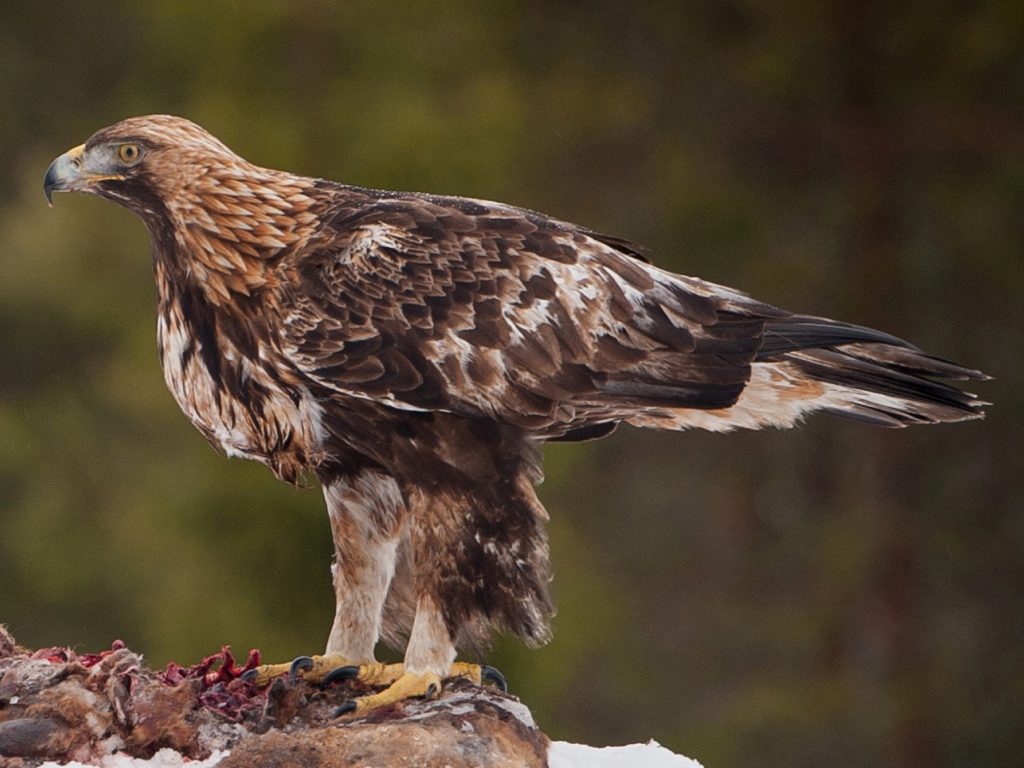In Alabama, two out of the four eagle species that inhabit North America have been sighted. These remarkable creatures, known as the Bald Eagle and Golden Eagle, hold a prominent position as the majestic rulers of the sky. Throughout history, humans have formed a deep connection with these regal birds, both emotionally and practically.
Humans have long admired the magnificence and power of eagles, often using them as symbols of strength and dominance. These birds have also been enlisted to aid in the act of hunting, showcasing their remarkable abilities. However, our relationship with eagles has not always been benevolent, as we have subjected them to persecution and the destruction of their habitats. This reckless behavior has driven many eagle species to the brink of extinction.
It is astonishing to note that eagles possess the extraordinary capability to carry objects weighing up to four times their own body weight. With a total of 60 eagle species existing worldwide, they are undeniably among the largest avian creatures. Interestingly, female eagles typically surpass their male counterparts in size.
For bird enthusiasts with a particular interest in birds of prey, I recommend exploring informative guides on hawks and vultures found in Alabama. Additionally, you can witness captivating live footage of eagle nesting activities and discover fascinating facts about the Bald Eagle.
To aid in the identification of eagle species observed in Alabama, a comprehensive guide has been compiled based on avibase data and the observations of avid bird watchers using ebird. This resource provides authentic information about the timing and locations of eagle sightings.
Species of Eagle in Alabama
1. Bald Eagle

In the state of Alabama, Bald Eagles can be encountered throughout the year, but their population tends to increase during the winter months from October to March. These magnificent birds have been recorded in approximately 1% of summer checklists and 6% of winter checklists submitted by diligent bird watchers.
The Bald Eagle, a widely recognized bird of prey, features a distinctive white head, yellow eyes, and a sizable, curved yellow beak. Its chocolate-brown body is complemented by yellow legs adorned with formidable talons. Female Bald Eagles resemble their male counterparts, albeit being approximately 25% larger. Juvenile Bald Eagles exhibit dark brown heads and bodies with variable white mottling or streaking, which gradually diminishes as they reach their fifth year of life.
- Scientific Name: Haliaeetus leucocephalus
- Length: 34 – 43 inches (86 – 109 cm)
- Weight: 168 ounces (4761 g)
- Wingspan: 72 – 96 inches (183 – 244 cm)
Bald Eagles primarily breed in Canada and migrate to the United States during winter, although some individuals choose to remain in their resident areas year-round, particularly in coastal regions. These eagles prefer nesting in wetland environments characterized by open, expansive bodies of water teeming with fish.
During nesting, roosting, or perching, Bald Eagles require tall, mature trees with a broad and open structure, enabling them to survey the forest floor. Proximity to water sources, especially during nesting, is essential. In the winter, Bald Eagles congregate in areas with ample perches surrounding unfrozen water, where fish are abundant. When unfrozen water sources are scarce, they gather in open habitats featuring medium-sized mammals, such as prairies and meadows.
Bald Eagles exhibit opportunistic feeding behavior and adapt their diet according to the available resources. Their preferred food source is fish, particularly larger species like trout and salmon. They either hunt fish themselves or pilfer them from other birds. Additionally, they consume carrion, including deceased fish. Medium to large-sized birds such as ducks, herons, owls, and geese are also part of their diet. In the winter months, when fishing is less productive, Bald Eagles shift their focus to mammals. They initially target weak, dying, or young prey, hunting rabbits, squirrels, raccoons, beavers, and deer fawns.
It is worth mentioning that the vocalizations of Bald Eagles do not align with their impressive size, as they emit a rather underwhelming high-pitched whistle.
Bald Eagles construct large and robust nests, capable of withstanding their considerable size and weight. These nests, built primarily with sticks, measure around 6 feet in diameter and 4 feet in height. The male procures materials such as sticks, grass, moss, and downy feathers, while the female skillfully assembles them into a sturdy structure.
It is noteworthy that Bald Eagle nests are recognized as the largest of any bird species in North America. In the wild, females typically lay one to three eggs per year, although in captivity, they have been known to lay up to seven eggs. The parents take turns incubating the eggs for a period of thirty-five days. While one parent attends to the eggs, the other embarks on hunting expeditions to provide sustenance for its partner.
Fun Fact: The Bald Eagle has held the position of America’s national symbol since 1782. Despite its name, the term “bald” originally referred to “white,” describing the bird’s white head and tail.
2. Golden Eagle

Golden Eagles are not frequently sighted in Alabama, but occasional winter sightings occur between November and March, primarily in the northern regions of the state.
Golden Eagles represent the most widely distributed eagle species globally. Their crown and nape exude a captivating golden-brown hue, particularly enchanting when illuminated by the right light conditions. Their bodies exhibit a darker shade of brown, accentuated by pale flight feathers. Eye coloration in Golden Eagles ranges from light yellow to dark brown. They possess a yellow cere, the skin on their beaks that connects to the forehead, while the tip of their bill appears dark.
Although adult Golden Eagles bear a similar appearance, females are noticeably larger than males. Juveniles resemble adults but tend to possess darker plumage, sometimes appearing black on their backs. Their wings display white patches on the undersides, and their tails feature sporadic white coloring.
- Scientific Name: Aquila chrysaetos
- Length: 27 – 38 inches (69 – 97 cm)
- Weight: 160 ounces (4534 g)
- Wingspan: 72 – 96 inches (183 – 244 cm)
Golden Eagles breeding in Canada and Alaska undertake migratory journeys southward to the United States and northern Mexico for the winter season. However, Golden Eagles residing in western U.S. states remain in their habitats throughout the year.
Mountainous regions situated well above treelines serve as the preferred habitats for Golden Eagles. Additionally, they inhabit canyons, cliffs along riversides, and bluffs when nesting, often displaying a preference for locations devoid of significant human presence.
For those seeking a bird’s-eye view of a Golden Eagle’s daily activities, a video showcasing their behavior is available below. Please proceed with caution if you have a fear of heights!
As birds of prey, Golden Eagles naturally prey on small to medium-sized animals such as rabbits, prairie dogs, and hares. On occasion, they may even target and capture larger prey like cranes, swans, and domestic livestock. Hunting in pairs, one eagle tirelessly pursues the prey until it becomes fatigued, allowing the other eagle to swoop in for the final strike.
The vocalizations of Golden Eagles primarily occur during the breeding season when chicks vocalize their needs, eliciting responses from their parents. At other times, Golden Eagles tend to remain relatively quiet, emitting infrequent high-pitched whistling calls.
Nests constructed by Golden Eagles are typically situated at high elevations, often on cliffs. However, they also utilize trees or artificial structures such as observation towers, nesting platforms, and even windmills. The elevated position of the nests provides the parents with an extensive view of their nesting and hunting grounds.
Building a Golden Eagle nest requires one to three months, utilizing sticks and plant material. Aromatic leaves are incorporated into the nest to deter insects and other pests. These nests are reused for several years, continually expanding in size as the adult eagles add more materials.
Females typically lay one to three eggs, and both parents alternate incubation duties for a period of forty-one to forty-five days. The hatching process takes approximately 37 hours.
Fun Fact: Among American birds of prey, only the Golden Eagle, Rough-legged Hawk, and Ferruginous Hawk possess feathers that extend down their legs, reaching their toes.
